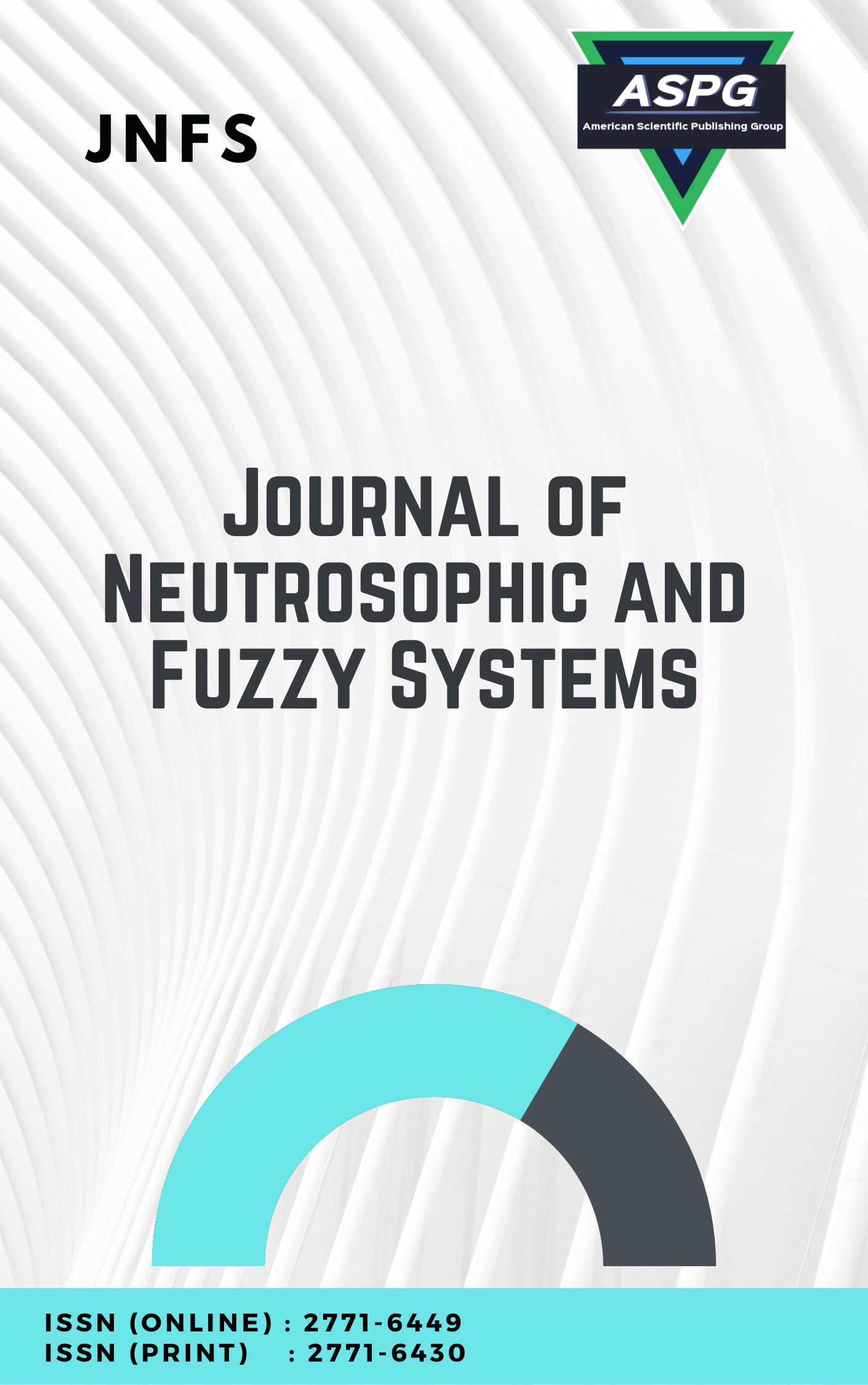

Volume 5 , Issue 2 , PP: 60-68, 2023 | Cite this article as | XML | Html | PDF | Full Length Article
Shereen Zaki 1 * , Mahmoud Ismail 2
Doi: https://doi.org/10.54216/JNFS.050206
An information system known as an enterprise resource planning (ERP) system is designed to organize and combine all of an organization's subsystems, such as marketing, manufacturing, finances, and purchasing transactions. The adoption of such a complete framework may result in significant cost reductions as well as time reductions for individual workers. This problem is solved by the interval-valued neutrosophic hypersoft set. A new area of research known as the hypersoft set is being established to resolve issues with the inadequacy and limitations of pre-existing models that are similar to soft sets in terms of the consideration and entitlement of multi-argument approximation functions. (This particular kind of function transfers the multi-sub parametric tuples to the power set of the universe. It concentrates on the splitting of each attribute into its own attribute-valued set, which is something that is lacking in current structures that are similar to soft sets.
Neutrosophic Sets , Hypersoft Set , ERP , Interval Valued Neutrosophic Sets , Resource planning , Soft Set
[1] C.-C. Wei, C.-F. Chien, and M.-J. J. Wang, “An AHP-based approach to ERP system selection,” International journal of production economics, vol. 96, no. 1, pp. 47–62, 2005.
[2] A. Deep, P. Guttridge, S. Dani, and N. Burns, “Investigating factors affecting ERP selection in made‐to‐order SME sector,” Journal of Manufacturing Technology Management, vol. 19, no. 4, pp. 430–446, 2008.
[3] X. B. Illa, X. Franch, and J. A. Pastor, “Formalising ERP selection criteria,” in Tenth International Workshop on Software Specification and Design. IWSSD-10 2000, 2000, pp. 115–122.
[4] E. Bernroider and S. Koch, “ERP selection process in midsize and large organizations,” Business Process Management Journal, vol. 7, no. 3, pp. 251–257, 2001.
[5] M. Haddara, “ERP selection: the SMART way,” Procedia technology, vol. 16, pp. 394–403, 2014.
[6] O. Alanbay, “ERP selection using expert choice software,” Honolulu, Hawaii, July, vol. 8, no. 10, 2005.
[7] N. Bhatt, S. Guru, S. Thanki, and G. Sood, “Analysing the factors affecting the selection of ERP package: a fuzzy AHP approach,” Information Systems and e-Business Management, vol. 19, pp. 641–682, 2021.
[8] O. Alaskari, R. Pinedo-Cuenca, and M. M. Ahmad, “Framework for Selection of ERP System: Case Study.,” Procedia Manufacturing, vol. 38, pp. 69–75, 2019.
[9] R. M. Czekster, T. Webber, A. H. Jandrey, and C. A. M. Marcon, “Selection of enterprise resource planning software using analytic hierarchy process,” Enterprise Information Systems, vol. 13, no. 6, pp. 895–915, 2019.
[10] M. S. Yurtyapan and E. Aydemir, “ERP software selection using intuitionistic fuzzy and interval grey number-based MACBETH method,” Grey Systems: Theory and Application, vol. 12, no. 1, pp. 78–100, 2022.
[11] M. del R. Pérez-Salazar, I. Rivera, and I. M. Cristóbal-Vázquez, “ERP selection: a literature review,” International Journal of Industrial and Systems Engineering, vol. 13, no. 3, pp. 309–324, 2013.
[12] D. Ratkevičius, Č. Ratkevičius, and R. Skyrius, “ERP selection criteria: theoretical and practical views,” Ekonomika, vol. 91, no. 2, pp. 97–116, 2012.
[13] C. J. Stefanou, “The selection process of enterprise resource planning (ERP) systems,” AMCIS 2000 Proceedings, p. 418, 2000.
[14] M. Saeed, M. Ahsan, M. H. Saeed, A. Mehmood, and T. Abdeljawad, “An application of neutrosophic hypersoft mapping to diagnose hepatitis and propose appropriate treatment,” IEEE Access, vol. 9, pp. 70455–70471, 2021.
[15] R. M. Zulqarnain, I. Siddique, R. Ali, F. Jarad, A. Samad, and T. Abdeljawad, “Neutrosophic hypersoft matrices with application to solve multiattributive decision-making problems,” Complexity, vol. 2021, pp. 1–17, 2021.
[16] M. Saqlain, N. Jafar, S. Moin, M. Saeed, and S. Broumi, “Single and multi-valued neutrosophic hypersoft set and tangent similarity measure of single valued neutrosophic hypersoft sets,” Neutrosophic Sets and Systems, vol. 32, no. 1, pp. 317–329, 2020.
[17] M. Saqlain, M. Saeed, M. R. Ahmad, and F. Smarandache, Generalization of TOPSIS for Neutrosophic Hypersoft set using Accuracy Function and its Application. Infinite Study, 2019.
[18] A. U. Rahman, M. Saeed, M. A. Mohammed, S. Krishnamoorthy, S. Kadry, and F. Eid, “An integrated algorithmic MADM approach for heart diseases’ diagnosis based on neutrosophic hypersoft set with possibility degree-based setting,” Life, vol. 12, no. 5, p. 729, 2022.
[19] M. Saeed, M. Ahsan, A. Mehmood, M. H. Saeed, and J. Asad, “Infectious diseases diagnosis and treatment suggestions using complex neutrosophic hypersoft mapping,” Ieee Access, vol. 9, pp. 146730–146744, 2021.
[20] M. Saeed, A. U. Rahman, and M. Arshad, “A study on some operations and products of neutrosophic hypersoft graphs,” Journal of Applied Mathematics and Computing, vol. 68, no. 4, pp. 2187–2214, 2022.
[21] M. Saeed, M. Ahsan, A. Ur Rahman, M. H. Saeed, and A. Mehmood, “An application of neutrosophic hypersoft mapping to diagnose brain tumor and propose appropriate treatment,” Journal of Intelligent & Fuzzy Systems, vol. 41, no. 1, pp. 1677–1699, 2021.
[22] A. U. Rahman, M. Saeed, A. Alburaikan, and H. A. E.-W. Khalifa, “An intelligent multiattribute decision-support framework based on parameterization of neutrosophic hypersoft set,” Computational Intelligence and Neuroscience, vol. 2022, 2022.
[23] M. N. Jafar, M. Saeed, M. Saqlain, and M.-S. Yang, “Trigonometric similarity measures for neutrosophic hypersoft sets with application to renewable energy source selection,” IEEE Access, vol. 9, pp. 129178–129187, 2021.
[24] M. Saqlain, M. Riaz, M. A. Saleem, and M.-S. Yang, “Distance and similarity measures for neutrosophic hypersoft set (NHSS) with construction of NHSS-TOPSIS and applications,” IEEE Access, vol. 9, pp. 30803–30816, 2021.